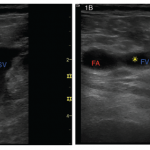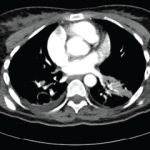NEW YORK (Reuters Health)—Low-molecular-weight heparin failed to prevent symptomatic venous thromboemboli in people receiving knee arthroscopy or a lower leg cast, according to a pair of studies conducted in the Netherlands.
The treatment is controversial because there is little clear evidence that heparin wards off clots in such instances. The research team, led by Dr. Raymond van Adrichem of the Leiden University Medical Center, followed 1,543 arthroscopy patients for eight days after their procedure and for the entire period of immobilization for the 1,451 who had a lower leg cast.
With arthroscopy, rates of venous thromboembolism were 0.7% with heparin and 0.4% without. With casting, the rates were 1.4% and 1.8% respectively, according to a report released online on Dec. 3 in the New England Journal of Medicine to coincide with a presentation at the American Society of Hematology Annual Meeting in San Diego.1
Major bleeding was seen in just two people in the arthroscopy study and in none of the volunteers with a leg cast.
More than 4 million people are treated with arthroscopic knee surgery every year.
“We can conclude that routine thromboprophylaxis with the standard regimen is not effective after knee arthroscopy or lower-leg casting,” the van Adrichem team writes. “In light of the high frequency of knee arthroscopy and casting worldwide, a considerable number of cases of venous embolism will nevertheless occur, and any possible prevention of these events should still be preferred.”
But a strategy of giving a higher dose for longer duration would likely only have a chance to be effective for high-risk groups, and that would be accompanied by a higher bleed risk, they warn.
The two trials were open label but the outcome evaluations were blinded. People with a history of venous thromboembolism were excluded.
“We intentionally chose a nonblinded design to reflect general practice, because patients may have different thresholds for contacting their doctor depending on their type of treatment,” the researchers note.
In the arthroscopy group, there were four confirmed cases of deep-vein thrombosis and one instance of pulmonary embolism among those getting heparin. Among those not given heparin, there were two confirmed cases of deep-vein thrombosis and one of pulmonary embolism.
The results were comparable when the analysis was restricted to patients who adhered to the treatment regimen.
The rates of clinically relevant nonmajor bleeding were 0.1% with heparin and 0.4% without. Minor bleeding rates were 9.5% and 5.4% respectively.
Among the patients who received a lower leg cast, there were six instances of deep-vein thrombosis and three cases of pulmonary embolism when heparin was given. One patient had both. In the control group, eight had deep-vein thrombosis, four had pulmonary embolism and one had both.
Once again, the per-protocol analysis showed that heparin offered little benefit.
There was just one case of clinically relevant non-major bleeding, and that was in the treatment group. The rates of minor bleeding were 7.6% with heparin and 6.8% without.
Because of the limitations of previous tests on heparin, the researchers write, “the need for stronger evidence regarding thromboprophylaxis for each of these indications has been expressed in several reviews and guidelines.”
The arthroscopic trial was known as POT-KAST. The leg cast study was named POT-CAST.
Reference
- van Adrichem RA, Nemeth B, Algra A, et al. Thromboprophylaxis after knee arthroscopy and lower-leg casting. N Engl J Med. 2016 Dec 3. Doi: 10.1056/NEJMoa1613303

